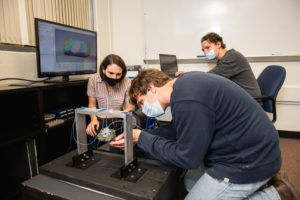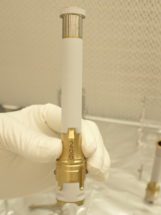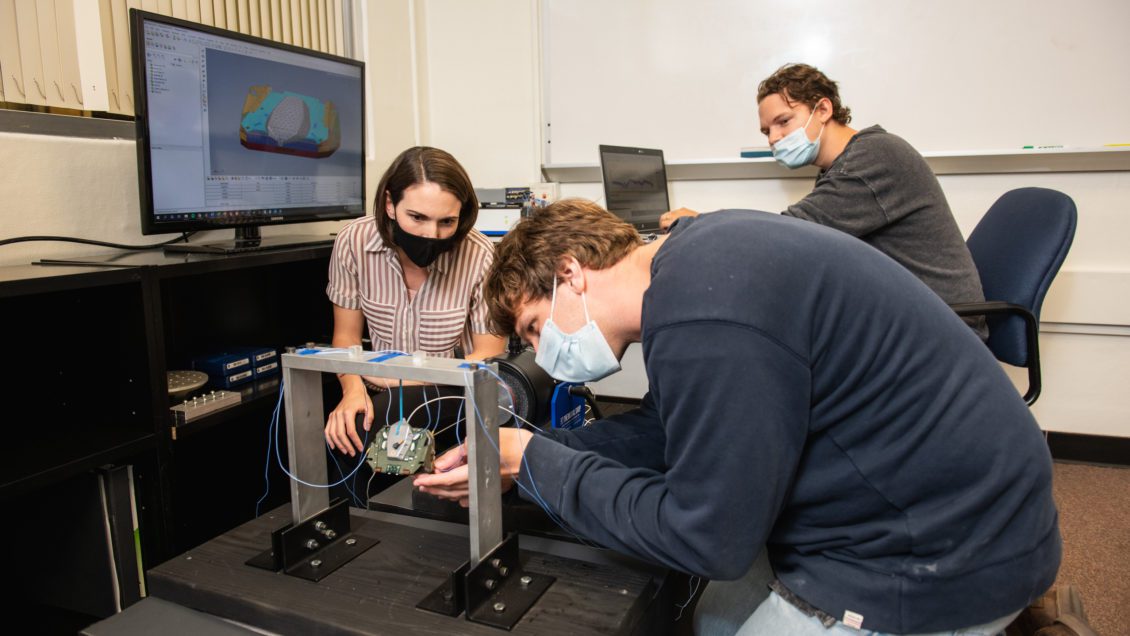When NASA’s Perseverance rover unfurled its arm to collect a rock sample on Mars, among the Earthlings paying attention was Laura Redmond of Clemson University.
Redmond worked four years as a structural engineer at NASA’s Jet Propulsion Laboratory before arriving at Clemson in 2018 as an assistant professor of civil engineering. While at NASA, she helped create sample tubes and their seals for the Perseverance mission.

The rover made history in September when it drilled into the Martian surface, extracted a rock core and sealed it in a titanium tube. It was the first time a spacecraft packed up a rock sample from another planet so that it could eventually be flown back to Earth by a future spacecraft, according to NASA.
If there was ever life on Mars, the rock samples contained in the tubes that Redmond helped create could be the evidence that proves it.
“It’s a little nerve-wracking, honestly,” Redmond said of watching the rover from 452 million miles away. “It was an exciting process, though, to see them working in space with the rover doing all of the sealing up there.”
Now that she is at Clemson, Redmond continues to find inspiration in worlds beyond Earth.
Some of her students, for example, conduct research with a Pop-up Folding Flat Explorer Robot (PUFFER). The robot is designed to fold up for transport and then unfold to scout the moon and possibly Mars. In a separate project, a group of undergraduate students who worked with Redmond as part of a summer program through the South Carolina Space Grant Consortium created a prototype of a six-legged robot designed to crawl through Martian lava tubes.

Eric Kulczycki, a JPL engineer, said that when Redmond worked at the laboratory, some of its best and brightest peppered her with tough questions, and she handled them well.
“She is easy to work with,” he said. “She is at the top of her game.”
Among the students conducting research under Redmond is John Bell, who is pursuing a Ph.D. He was the first student in her lab to work on PUFFER and now executes the structural dynamic testing used to correlate models of PUFFER.
“Every day brings a new challenge where one day I’m looking at signal processing, the other I’m diving into coding,” Bell said. “I do a lot of hands-on work as well. The variability of my work never gets old.”
Redmond’s early experience in engineering was more terrestrial than her space-inspired work. She studied seismic behavior of masonry and concrete structures for her Ph.D. at the Georgia Institute of Technology and continues to conduct research in the field and on other Earth-bound topics, including structural health monitoring of bridges.
Finite element modeling and dynamic testing, she said, applies just as well to buildings and bridges as to rockets.
“The math is the same,” Redmond said “Whether it’s earthquakes producing the ground motion or the rocket producing the base acceleration, it’s the same process you’re going through.”
John Crowder has enjoyed the benefit of Redmond’s wide-ranging expertise. He took a concrete class with her as an undergraduate, liked how she taught and found that he used his notes when he worked for a company as part of the cooperative education program.
Crowder later received his Bachelor of Science in civil engineering and returned to Redmond’s lab as master’s student. He is now working on PUFFER.
“It definitely hits me once a week where I’m like, ‘Wow, I can’t believe I’m doing this,’” he said. “Especially when I talk to my parents. I’ll start talking and all of a sudden I’ll realize it’s been an hour.”
Redmond said she found her way to Clemson while looking for an opportunity to invest in people and students.
“JPL was awesome, amazing, and Clemson is also awesome, amazing,” she said. “I enjoy the fact that now I get to bring up and inspire students to do what they want to do and get excited about space and space research. I also enjoy that I can recruit from a variety of backgrounds.”
Jesus M. de la Garza, chair of the Glenn Department of Civil Engineering, said that Redmond is well positioned for success.
“Her past experience has opened new avenues for her students to conduct research with NASA,” he said. “The collaboration is widening the pipeline between Clemson and NASA and creating a new generation of engineers who will be knowledgeable and experienced in cutting-edge technologies and techniques. I congratulate her on the success she has enjoyed in the short time she has been here.”
Detailed analysis of what exactly is in the tubes and seals that Redmond and Kulczycki helped design is going to have to wait at least for a few years until they’re returned to Earth. NASA and the European Space Agency are exploring the next steps to collect the samples and launch them into Martian orbit, where they would be captured by an orbiter, which would then head for Earth.
If all goes as planned, the Martian samples would arrive on the blue planet as early as 2031.
Get in touch and we will connect you with the author or another expert.
Or email us at news@clemson.edu

